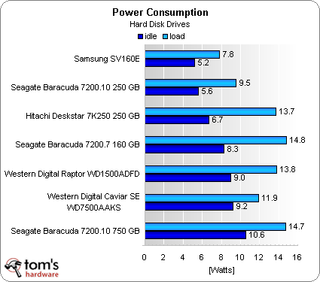Energy-Efficient Computing Options
Hard Drives

UPDATE: When this article was published the hard drive power consumption chart included results that were much lower across the board. We found that the voltmeter we had used for the tests was broken, and we had to repeat the measurements. The results and statements below are now accurate.
If you compare the differences of hard drive power requirements to what you can save by smart processor or hard drive choices, the differences certainly are almost negligible. However, there are considerable differences between hard drive models. As expected, a WD Raptor at 10,000 RPM required more energy than a 7,200 RPM hard drive. Yet, this only applies to current-generation products, as a five-year old Seagate Barracuda 7200.7 drive at 160 GB has a higher maximum power requirement than a 10,000 RPM Raptor or a 750 GB hard drive by Seagate or WD.
WD has announced that its next hard drive generation with up to 1 TB capacity will be 40% more energy efficient than current models. Looking at idle power requirements of 10.6 W (Seagate 7200.10 750 GB) and 9.2 W (WD Caviar WD7500AAKS), this doesn't seem easy at first glance. However, there already are hard drives that operate with as little as 5.2 W when idle; we were amazed to see that a Samsung SV160E required this small amount of power.
Stay on the Cutting Edge
Join the experts who read Tom's Hardware for the inside track on enthusiast PC tech news — and have for over 25 years. We'll send breaking news and in-depth reviews of CPUs, GPUs, AI, maker hardware and more straight to your inbox.
Most Popular

